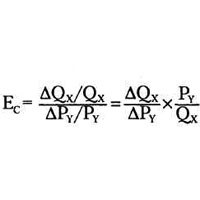You will need
- -the initial price of good 1 (P1)
- -the final price of good 1 (P2)
- -the initial demand for product 2 (Q1)
- -the final demand for product 2 (Q2)
Instruction
1
To assess the cross elasticity you can use two methods of calculating arc and point. Point method definition of cross elasticity can be used when derived the functional relationship of dependent objects (i.e. a function of demand or supply of any goods). The arc method is used in cases when practical observations do not allow to identify the functional relationship between the we are interested in market indicators. In this situation, the estimated market reaction during the transition from one point to another (i.e. takes start and end values we are interested in the topic).
2
In order to more clearly explain the method of determining the cross elasticity (arc method), let's take a concrete problem: what is the cross elasticity of goods, if the decrease in the price of margarine from 70 to 63 p., the sale of oil in the store decreased from 500 to 496 units per month?Calculate the change of volume of demand for the second product (in this case butter).∆Qₓ=(Q2-Q1)=496-500=-4
3
Calculate the change for the second product (in this example, margarine).∆Pᵧ=(P2-P1)=63-70=-7
4
Calculate the coefficient cross elasticity.Eշ=∆Qₓ*Pᵧ/∆Pᵧ*QₓEշ=((-4)*70)/ ((-7)*500)=0,08 (by lowering the price of margarine by 1% the demand for oil has decreased on 0,08%)
5
Analyze the obtained result. The higher the cross elasticity, the stronger the relationship of the goods. Conversely, the closer this figure is to zero, the weaker the relationships of substitution or addition. In this case, the coefficient of cross elasticity slightly greater than zero. Exploring the goods are the goods-substitutes. The drop in the price of margarine has little effect on the demand for butter. However, if you change the price of oil, the demand for margarine will change much stronger. This is because the cross - elasticity can be asymmetrical, when the dependence of the products is more one-sided. For example, laptops and laptop cases. By lowering the price of laptops the demand for the cases for them will increase significantly. But with decreasing prices for computer cases, demand for the notebook computers themselves will not change.
Note
Cross-elasticity is a dimensionless quantity, and this value does not depend on in any unit were measured prices, volume of sales or other parameters. It is not expressed in any units!
Useful advice
Cross-elasticity is not used for abstract calculations, but for predicting the behavior of the studied product if you change the number of conditions.
Eշ > 0 shows that the studied interchangeable products (substitutes). The increase in the price of one good leads to an increase in demand for the other.
Eշ < 0 indicates complementary goods (gin and tonic). The increase in the price of one commodity leads to a decrease in demand for the other.
Eշ = 0 independent goods vehicle ( and cocoa). The price of one product has no effect on the other.
Eշ > 0 shows that the studied interchangeable products (substitutes). The increase in the price of one good leads to an increase in demand for the other.
Eշ < 0 indicates complementary goods (gin and tonic). The increase in the price of one commodity leads to a decrease in demand for the other.
Eշ = 0 independent goods vehicle ( and cocoa). The price of one product has no effect on the other.
